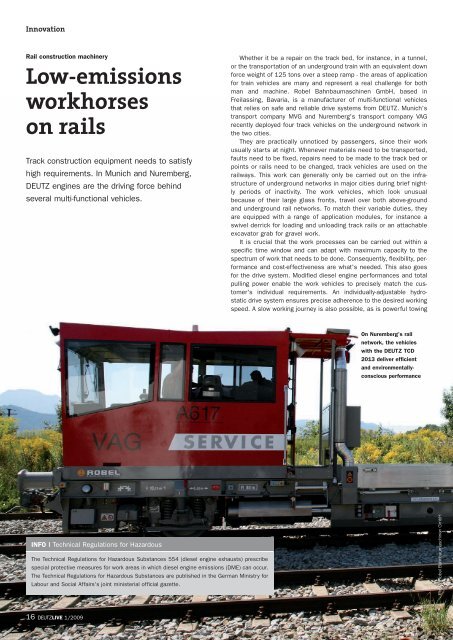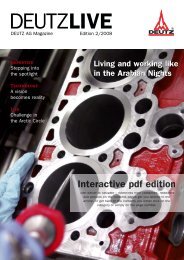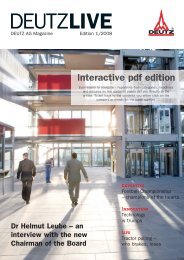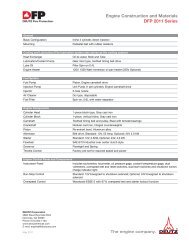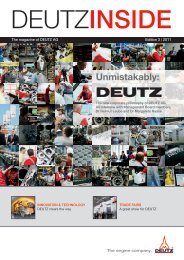deutz live 1/2009
deutz live 1/2009
deutz live 1/2009
You also want an ePaper? Increase the reach of your titles
YUMPU automatically turns print PDFs into web optimized ePapers that Google loves.
Innovation<br />
Rail construction machinery<br />
Low-emissions<br />
workhorses<br />
on rails<br />
Track construction equipment needs to satisfy<br />
high requirements. In Munich and Nuremberg,<br />
DEUTZ engines are the driving force behind<br />
several multi-functional vehicles.<br />
INFO | Technical Regulations for Hazardous<br />
The Technical Regulations for Hazardous Substances 554 (diesel engine exhausts) prescribe<br />
special protective measures for work areas in which diesel engine emissions (DME) can occur.<br />
The Technical Regulations for Hazardous Substances are published in the German Ministry for<br />
Labour and Social Affairs's joint ministerial official gazette.<br />
16 DEUTZLIVE 1/<strong>2009</strong><br />
Whether it be a repair on the track bed, for instance, in a tunnel,<br />
or the transportation of an underground train with an equivalent down<br />
force weight of 125 tons over a steep ramp - the areas of application<br />
for train vehicles are many and represent a real challenge for both<br />
man and machine. Robel Bahnbaumaschinen GmbH, based in<br />
Freilassing, Bavaria, is a manufacturer of multi-functional vehicles<br />
that relies on safe and reliable drive systems from DEUTZ. Munich's<br />
transport company MVG and Nuremberg's transport company VAG<br />
recently deployed four track vehicles on the underground network in<br />
the two cities.<br />
They are practically unnoticed by passengers, since their work<br />
usually starts at night. Whenever materials need to be transported,<br />
faults need to be fixed, repairs need to be made to the track bed or<br />
points or rails need to be changed, track vehicles are used on the<br />
railways. This work can generally only be carried out on the infrastructure<br />
of underground networks in major cities during brief nightly<br />
periods of inactivity. The work vehicles, which look unusual<br />
because of their large glass fronts, travel over both above-ground<br />
and underground rail networks. To match their variable duties, they<br />
are equipped with a range of application modules, for instance a<br />
swivel derrick for loading and unloading track rails or an attachable<br />
excavator grab for gravel work.<br />
It is crucial that the work processes can be carried out within a<br />
specific time window and can adapt with maximum capacity to the<br />
spectrum of work that needs to be done. Consequently, flexibility, performance<br />
and cost-effectiveness are what's needed. This also goes<br />
for the drive system. Modified diesel engine performances and total<br />
pulling power enable the work vehicles to precisely match the customer's<br />
individual requirements. An individually-adjustable hydrostatic<br />
drive system ensures precise adherence to the desired working<br />
speed. A slow working journey is also possible, as is powerful towing<br />
On Nuremberg's rail<br />
network, the vehicles<br />
with the DEUTZ TCD<br />
2013 de<strong>live</strong>r efficient<br />
and environmentallyconscious<br />
performance<br />
Photo: Robel Bahnbaumaschinen GmbH


